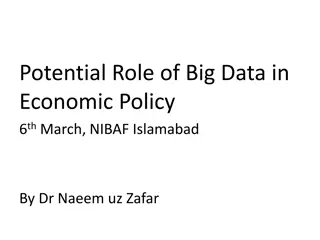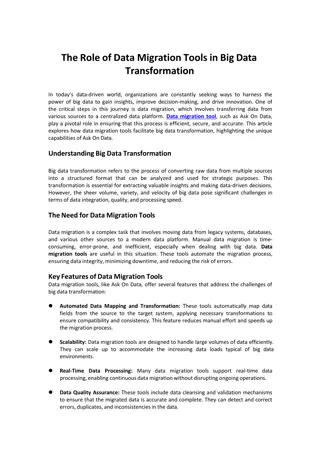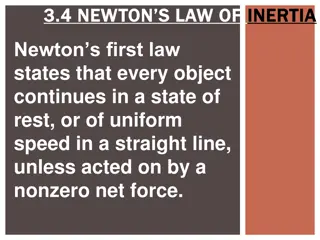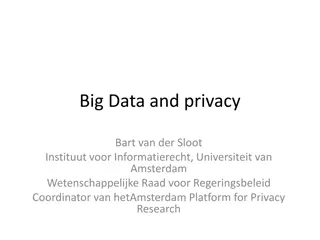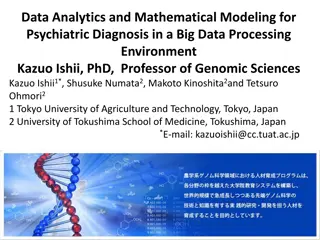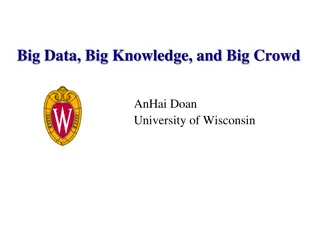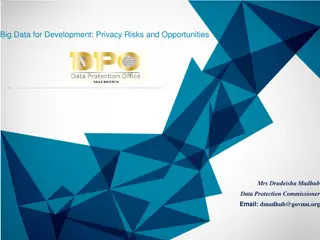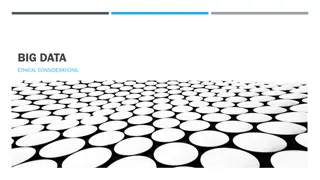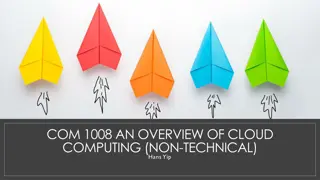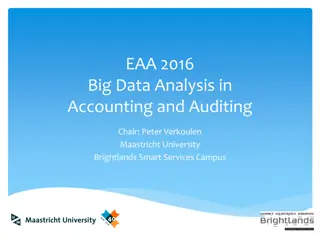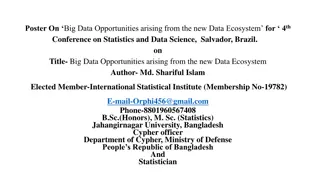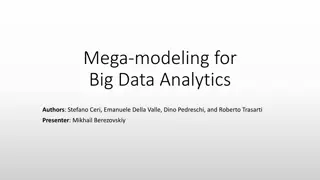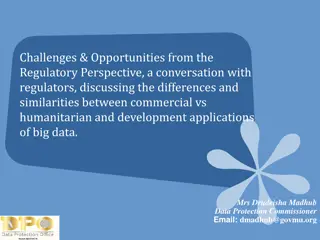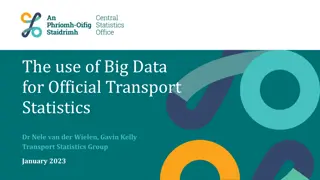Managing Big Data at Rest with Alexander Semenov, PhD
Dive into the world of data at rest with Alexander Semenov, a Ph.D. specializing in managing large datasets. Explore topics such as databases, NoSQL, parallel programming, and scaling techniques. Understand the importance of handling inactive data stored in various digital forms and learn about the challenges and solutions in today's data-rich environment.
Download Presentation

Please find below an Image/Link to download the presentation.
The content on the website is provided AS IS for your information and personal use only. It may not be sold, licensed, or shared on other websites without obtaining consent from the author.If you encounter any issues during the download, it is possible that the publisher has removed the file from their server.
You are allowed to download the files provided on this website for personal or commercial use, subject to the condition that they are used lawfully. All files are the property of their respective owners.
The content on the website is provided AS IS for your information and personal use only. It may not be sold, licensed, or shared on other websites without obtaining consent from the author.
E N D
Presentation Transcript
Managing with Big Data at rest Alexander Semenov, PhD
Introduction Degree in Electrical Engineering, Saint-Petersburg State Electrotechnical University, 2008 PhD thesis Principles of social media monitoring and analysis software , defended in May 2013 Main topic is analysis of social media sites and software for it, supervised by Prof. Jari Veijalainen Visiting scholar in University at Buffalo, NY, USA; University of Memphis, TN, USA, University of Florida, FL, USA Currently postdoctoral researcher in CS&IS Dept Previous project: computational logistics, spinned of as NFleet Current projects: MineSocMed, VISIT, CyberSHOK (security)
Table of contents Lecture 1 Introduction, Data at rest Databases, relational databases PostgreSQL NoSQL databases, JSON ACID vs BASE, CAP theorem Examples: Redis, MongoDB, CouchDB
Table of contents Lectures 2 and 3 Parallel programming MapReduce Apache Hadoop HDFS Hbase Pig Hive Apache Spark
Data at rest Data at rest is inactive data which is stored physically in any digital form (e.g. databases, data warehouses, spreadsheets, archives, tapes, off- site backups, mobile devices etc.) Data at Rest generally refers to data stored in persistent storage (disk, tape) while Data in Use generally refers to data being processed by a computer central processing unit Data in Use data being used and processed by CPU Data in Motion data that is being moved
Scaling Recall from previous lecture: from 2013 to 2020, the digital universe will grow by a factor of 10 from 4.4 ZB to 44 ZB. It more than doubles every two years. zettabyte equals to 10^21 bytes For handling these data computing performance and data storages should scale To scale vertically means to add resources to a single node in a system, typically involving the addition of CPUs or memory to a single computer To scale horizontally (or scale out) means to add more nodes to a system, such as adding a new computer to a distributed software application.
Scaling Now, manufacturers of CPUs prefer horizontal scaling Multicore CPU Multiprocessor CPU Data are stored in distributed storages Distributed systems are used to process the data Distributed computing introduce problems with synchronization
Why do we need databases? Assume you need to develop a software system for supermarket chain: Retrieve every sale in every single store Retrieve sales per day Retrieve sale per region Retrieve sales per product How do you do it? How to find the data How to query the data How many files you need? What happens, if several users modify the data?
Databases Data may be stored in the databases A database is an organized collection of data Database management systems (DBMSs) are computer software applications that interact with the user, other applications, and the database itself to capture and analyze data.
Benefits of the databases Efficient data access Data independence Data integrity Data administration Concurrent access and crash recovery Reduced application development time
Database architecture From Fundamentals of Database Systems(Elmasri,Navathe), 2010
Relational databases A relational database management system (RDBMS) is a database management system (DBMS) that is based on the relational model The central concept in relational model is the relation: set of rows, represented as a table RelationName(field1:type1, field2:type2, ,fieldN:typeN) The relational database model is based on the concept of two-dimensional tables. Proposed by Edgar Frank "Ted" Codd from IBM in 1970.
SQL SQL standard query language. Language designed for managing data held in RDBMS select first, last, city from empinfo; select last, city, age from empinfo where age > 40; select * from empinfo where first = 'Eric'; From Fundamentals of Database Systems(Elmasri,Navathe), 2010
SQL Table can be created Create table table_name (a int,b int, c int); Data can be inserted or updated Insert into table_name(a,b,c) values(1,2,10); Create statement defines table schema; after that, the data should correspond to this schema Schema can be edited ( alter table x add column id int ); Generally, RDBMS require fixed schema
SQL Using SQL rows can be selected from the table based on some predicates Select * from table_name where a > b and c = 10; Table elements can be counted Select count(*) from table_name; Multiple tables can be joined Rows can be grouped
SQL, JOIN Combines columns from several tables CROSS JOIN Returns Cartesian product of the tables SELECT * FROM employee CROSS JOIN department; SELECT * FROM employee, department INNER JOIN creates a new result table by combining column values of two (or more) tables SELECT * FROM weather INNER JOIN cities ON (weather.city = cities.name); Matches only those values, which exist in both tables
SQL, JOIN create table employee(id serial, name text, dept int); create table department(id int, name text); insert into employee(name, dept) values('Alice', 1), ('Bob', 2), ('Alex', 1); insert into department (name, id) values('Computer Science', 1), ('Operations Research', 2); select * from employee join department on employee.dept = department.id;
SQL support There are SQL standards: SQL-86, SQL-89, SQL-92, , SQL:2008, SQL:2011 Considered one of the major reasons for the commercial success of relational databases A number of RDBMS support SQL, some of them add some extensions Oracle Database Microsoft SQL Server MySQL IBM DB2 PostgreSQL SQlite Other tools: Apache Hive Big SQL
DB rankings From http://db-engines.com/en/ranking
Example: PostgreSQL Implements majority of SQL:2011 standard Free and open source software, can be downloaded from http://postgresql.org Runs on Linux, FreeBSD, and Microsoft Windows, and Mac OS X Has interfaces for many programming languages, including C++, Python, PHP, and so on From 9.2 supports JSON data type Transactional and ACID compliant Has many extensions, such as PostGIS (a project which adds support for geographic objects) Supports basic partitioning http://www.postgresql.org/docs/current/static/ddl-partitioning.html
Example: PostgreSQL Maximum Database Size Maximum Table Size Maximum Row Size Maximum Field Size Maximum Rows per Table Maximum Columns per Table 250 1600 Maximum Indexes per Table Unlimited Unlimited 32 TB 1.6 TB 1 GB Unlimited Is this a Big Data ?
ACID properties A transaction comprises a unit of work performed within a database management system (or similar system) against a database Must have ACID properties: Atomicity, Consistency, Isolation, Durability Atomicity Atomicity requires that each transaction be "all or nothing": if one part of the transaction fails, the entire transaction fails, and the database state is left unchanged.
ACID properties Consistency The consistency property ensures that any transaction will bring the database from one valid state to another. Any data written to the database must be valid according to all defined rules Isolation The isolation property ensures that the concurrent execution of transactions result in a system state that would be obtained if transactions were executed serially, i.e. one after the other Durability Durability means that once a transaction has been committed, it will remain so, even in the event of power loss, crashes, or errors.
Summary SQL offers very powerful querying mechanism Advanced algorithms are used for query execution cache Data in RDBMS should be described by fixed schema RDBMS software is usually very advanced ACID properties (atomicity, consistency, integrity, durability) May add overhead (e.g. while checking consistency, etc)
NoSQL databases Carlo Strozzi first used the term NoSQL in 1998 as a name for his open source relational database that did not offer a SQL interface The term was reintroduced in 2009 by Eric Evans in conjunction with an event discussing open source distributed databases NoSQL stands for Not Only SQL
NoSQL databases Broad class of database management systems that differ from the classic model of the relational database management system (RDBMS) in some significant ways, most important being they do not use SQL as their primary query language Do not have fixed schema Do not use join operations May not have ACID (atomicity, consistency, isolation, durability) Scale horizontally Are referred to as Structured storages
JSON Very often, data comes in JSON format JavaScript Object Notation Popular; there are JSON parsers in many languages, many sites provide JSON interfaces Types: Number String Boolean Null Object {} (similar to Python dictionary) Array Many NoSQL databases can import JSON documents directly
JSON 1. [ 100, 500, 300, 200, 400 ] 2. { "firstName": "John", "lastName": "Smith", "age": 25, "address": { "streetAddress": "21 2nd Street", "city": "New York", "state": "NY", "postalCode": 10021 }, "phoneNumbers": [ { "type": "home", "number": "212 555-1234" }, { "type": "fax", "number": "646 555-4567" } ] }
ACID vs BASE ACID is contrasted with BASE BASE: Basically available there will be a response to any request. But, that response could be a failure to obtain the requested data or the data may be in an inconsistent or changing state. Soft-state The state of the system could change over time, so even during times without input there may be changes going on due to eventual consistency Eventual consistency The system will eventually become consistent once it stops receiving input. The data will propagate to everywhere it should sooner or later
ACID vs BASE Taken from http://www.christof-strauch.de/nosqldbs.pdf
ACID vs BASE Strict Consistency All read operations must return data from the latest completed write operation, regardless of which replica the operations went to Eventual Consistency Readers will see writes, as time goes on: "In a steady state, the system will eventually return the last written value".
CAP theorem States that it is impossible for a distributed computer system to simultaneously provide all three of the following guarantees Consistency A distributed system is typically considered to be consistent if after an update operation of some writer all readers see his updates in some shared data source Availability a system is designed and implemented in a way that allows it to continue operation Partition tolerance These occur if two or more islands of network nodes arise which (temporarily or permanently) cannot connect to each other; dynamic addition and removal of nodes
CAP theorem Taken from http://www.christof-strauch.de/nosqldbs.pdf
CAP theorem Taken from http://guide.couchdb.org
NoSQL databases: motives Avoidance of Unneeded Complexity Relational databases provide a variety of features and strict data consistency. But this rich feature set and the ACID properties implemented by RDBMSs might be more than necessary for particular applications and use cases High Throughput Google is able to process 20 petabyte a day stored in Bigtable via it s MapReduce approach Taken from http://www.christof-strauch.de/nosqldbs.pdf
NoSQL databases: motives Horizontal Scalability and Running on Commodity Hardware for Web 2.0 companies the scalability aspect is considered crucial for their business Avoidance of Expensive Object-Relational Mapping important for applications with data structures of low complexity that can hardly benefit from the features of a relational database when your database structure is very, very simple, SQL may not seem that beneficial Taken from http://www.christof- strauch.de/nosqldbs.pdf
NoSQL databases: motives Movements in Programming Languages and Development Frameworks Ruby on Rails framework and others try to hide away the usage of a relational database NoSQL datastores as well as some databases offered by cloud computing providers completely omit a relational database Cloud computing needs Taken from http://www.christof-strauch.de/nosqldbs.pdf
NoSQL databases: criticism Skepticism on the Business Side As most of them are open-source software they are well appreciated by developers who do not have to care about licensing and commercial support issues NoSQL as a Hype Overenthusiasm because of the new technology NoSQL as Being Nothing New NoSQL Meant as a Total No to SQL
Data and query models Taken from http://www.christof-strauch.de/nosqldbs.pdf
NewSQL NewSQL is a class of modern relational database management systems that seek to provide the same scalable performance of NoSQL system, still maintaining the ACID guarantees of a traditional database system The term was first used by 451 Group analyst Matthew Aslett in a 2011 research paper One of the most important features is transparent sharding Examples: dbShards, Scalearc, and ScaleBase
NoSQL example: Redis REmote DIctionary Server http://redis.io http://try.redis.io/ - contains interactive tutorial Number 1 in db-engines.com key-value stores ranking Lightweight key-value storage Stores data in RAM Supports replication
NoSQL example: Redis Supports strings, lists, sets, sorted sets, hashes, bitmaps, and hyperloglogs (probabilistic data structure used for approximate count of distinct elements) See http://redis.io/topics/data-types-intro > set mykey somevalue OK > get mykey "somevalue"
NoSQL example: Redis > set counter 100 OK > incr counter (integer) 101 > incr counter (integer) 102 > incrby counter 50 (integer) 152
NoSQL example: Redis > set key some-value OK > expire key 5 (integer) 1 > get key (immediately) "some-value" > get key (after some time) (nil)
NoSQL example: Redis > rpush mylist A (integer) 1 > rpush mylist B (integer) 2 > lpush mylist first (integer) 3 > lrange mylist 0 -1 1) "first" 2) "A" 3) "B rpop mylist B
NoSQL example: Redis > hmset user:1000 username antirez birthyear 1977 verified 1 OK > hget user:1000 username "antirez" > hget user:1000 birthyear "1977" > hgetall user:1000 1) "username" 2) "antirez" 3) "birthyear" 4) "1977" 5) "verified" 6) "1"
MongoDB cross-platform document-oriented database Stores documents , data structures composed of field and value pairs From http://www.mongodb.org/ Key features: high performance, high availability, automatic scaling, supports server-side JavaScript execution Has interfaces for many programming languages
MongoDB > use mongotest switched to db mongotest > > j = { name : "mongo" } { "name" : "mongo" } > j { "name" : "mongo" } > db.testData.insert( j ) WriteResult({ "nInserted" : 1 }) > > db.testData.find(); { "_id" : ObjectId("546d16f014c7cc427d660a7a"), "name" : "mongo" } > > > k = { x : 3 } { "x" : 3 } > show collections system.indexes testData > db.testData.findOne()
MongoDB > db.testData.find( { x : 18 } ) > db.testData.find( { x : 3 } ) > db.testData.find( { x : 3 } ) > db.testData.find( ) { "_id" : ObjectId("546d16f014c7cc427d660a7a"), "name" : "mongo" } > > db.testData.insert( k ) WriteResult({ "nInserted" : 1 }) > db.testData.find( { x : 3 } ) { "_id" : ObjectId("546d174714c7cc427d660a7b"), "x" : 3 } > > var c = db.testData.find( { x : 3 } ) > c { "_id" : ObjectId("546d174714c7cc427d660a7b"), "x" : 3 }



